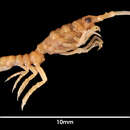en
names in breadcrumbs


“Cylindrarcturus elongatus sp. nov.
Diagnosis. See generic diagnosis.
Description. Eyes very large and laterally placed. Body smooth without spines. Cephalon and peraeonal segments fused. Peraeonal segment IV not noticeably longer than other peraeonal segments. Pleon with segments indicated, cylindrical, elongate posterior margin produced to long acutely ending point. Antenna 1 with flagellum shorter than three peduncular segments; about seven aesthetacs on over half of margin. Antenna 2 shorter than length of body; four long flagellar articles. Maxilliped with palp slightly longer than endite; sensory edge with many setae; exopod with rounded apical margin. Peraeopod I short, gnathal, and with short unguis on normal dactylus. Peraeopod II with basis about as long as ischium and merus combined; carpus and propodus each less in length than combined basal segments; dactylus proper short, about as long as merus and supporting slightly longer unguis. Valve smooth.
Measurements. Holotype gravid female 12.4 mm long.
Type locality. Anvers Island region; Hero 721-726; 62°19.3'S, 59°11.8'W; 62°19.2'S, 59°11.7'W; December 26, 1971; 64-89 m.
Derivation of name. The species name 'elongatus' refers to the elongate body, especially the pleon with its long posterior margin.
Distribution. Known only from type locality.
Affinities. The presence of an unguis on the dactylus of peraeopod I suggests that the species is more related to the Arcturus-like members of the genus rather than the Astacilla-like members, as the general body shape suggests.”
(Schultz, George, 1981: 84-87)